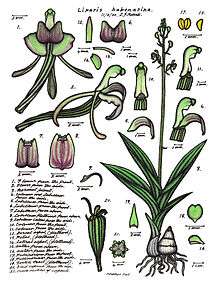Liparis habenarina
Liparis habenarina, commonly known as the common sphinx orchid[2] or common hobgoblin orchid,[3] is a plant in the orchid family and is endemic to Australia. It is a deciduous, terrestrial orchid with two or three egg-shaped leaves and between eight and twenty-two brownish to purplish flowers with their lateral sepals joined at the base. It grows in the understorey of near-coastal forests.
| Common sphinx orchid | |
|---|---|
 | |
| Illustration of Liparis habenarina by Lewis Roberts | |
| Scientific classification | |
| Kingdom: | Plantae |
| Clade: | Tracheophytes |
| Clade: | Angiosperms |
| Clade: | Monocots |
| Order: | Asparagales |
| Family: | Orchidaceae |
| Subfamily: | Epidendroideae |
| Tribe: | Malaxideae |
| Genus: | Liparis |
| Species: | L. habenarina |
| Binomial name | |
| Liparis habenarina | |
| Synonyms[1] | |
Description
Liparis habenarina is a terrestrial, deciduous herb with two underground pseudobulbs, each of which lasts for one season. There are usually three, thin, pleated, egg-shaped leaves 100–250 mm (4–10 in) and 20–40 mm (0.8–2 in) wide with five obvious veins. Between eight and twenty two brownish to purplish flowers, 10–25 mm (0.4–1 in) long and 5–6 mm (0.20–0.24 in) wide are borne on an upright flowering stem 150–600 mm (6–20 in) long. The dorsal sepal is 5–10 mm (0.2–0.4 in) long, 1–2 mm (0.04–0.08 in) wide and turns downward. The lateral sepals are 5–8 mm (0.2–0.3 in) long, 1–3 mm (0.04–0.1 in) wide and joined to each other. The petals are a similar length but only about 1 mm (0.04 in) wide and curve downwards. The labellum is egg-shaped with the narrower end towards the base and curves downwards. It is 4–5 mm (0.16–0.20 in) long and 2–4 mm (0.08–0.2 in) wide with two ridges near its base, a greenish centre and wavy edges. Flowering occurs between January and May.[3][4][5]
Taxonomy and naming
The common sphinx orchid was first formally described in 1864 by Ferdinand von Mueller who gave it the name Sturmia habenarina and published the description in Fragmenta phytographiae Australiae. The description was based on a specimen collected near Rockingham Bay by John Dallachy. In the description, von Mueller noted Liparis habenarina as a synonym.[6][7] In 1873, George Bentham changed the name to Liparis habenarina and published the name change in Flora Australiensis.[8][9] The specific epithet (habenarina) refers to the similarity of this species to those in the orchid genus Habenaria.[2]
Distribution and habitat
Liparis habenarina grows with grasses in the understorey of forests, usually near the edge of swamps in near-coastal areas. It is found in New South Wales north from Coffs Harbour, in coastal Queensland, the Northern Territory and the Northern Kimberley biogeographic region of Western Australia.[1][5][10] Authorities using the name Empusa habenarina list the range as extending to New Guinea and Indonesia.[3][4]
References
- "Liparis habenarina". World Checklist of Selected Plant Families (WCSP). Royal Botanic Gardens, Kew.
- Brown, Andrew; Dixon, Kingsley; French, Christopher; Brockman, Garry (2013). Field guide to the orchids of Western Australia : the definitive guide to the native orchids of Western Australia. Simon Nevill Publications. p. 498. ISBN 9780980348149.
- Jones, David L. (2006). A complete guide to native orchids of Australia including the island territories. Frenchs Forest, N.S.W.: New Holland. p. 274. ISBN 1877069124.
- "Empusa habenarina". trin keys. Retrieved 24 October 2018.
- Harden, Gwen (ed.) (1993). Flora of New South Wales (Volume 4). Kensington, N.S.W.: New South Wales University Press. p. 226. ISBN 0868401889.CS1 maint: extra text: authors list (link)
- "Sturmia habenarina". APNI. Retrieved 23 October 2018.
- von Mueller, Ferdinand; Bentham, George (1864). Fragmenta phytographiae Australiae (Volume 4). Melbourne: Victorian Government Printer. p. 131. Retrieved 24 October 2018.
- "Liparis habenarina". APNI. Retrieved 23 October 2018.
- Bentham, George; von Mueller, Ferdinand (1873). Flora Australiensis (Volume 6). London: Lovell Reeve and Co. pp. 273–274. Retrieved 24 October 2018.
- "Liparis habenarina". FloraBase. Western Australian Government Department of Parks and Wildlife.
| Wikimedia Commons has media related to Liparis habenarina. |